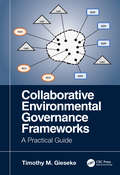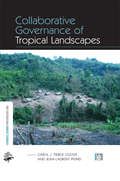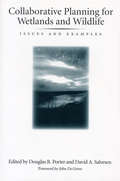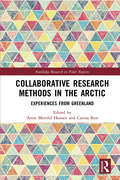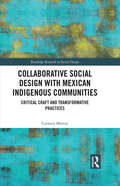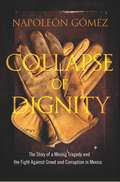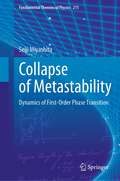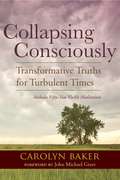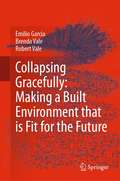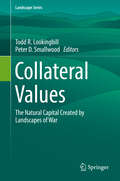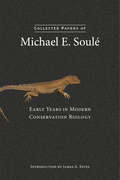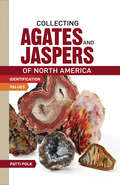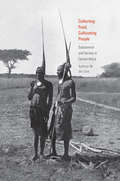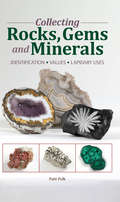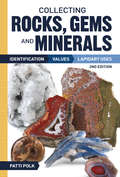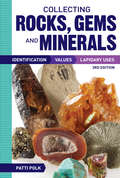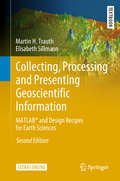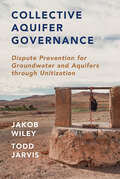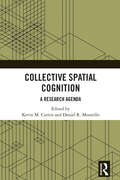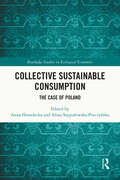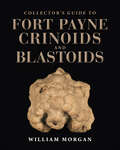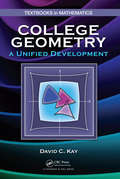- Table View
- List View
Collaborative Environmental Governance Frameworks: A Practical Guide
by Timothy GiesekeThis book takes a practical approach to understanding and describing collaborative governance for resolving environmental problems. It introduces a new collaborative governance assessment model and recognizes that collaborations are a natural result of organizations converging around complex issues. Rather than identifying actors by their type of organization, the actors are identified by the type of role they play. This approach is aligned with how individuals and organizations interact in practice, and their dependance on collaborations to solve emerging environmental problems. The book discusses real cases with governance issues and creates new frameworks for collaborations. Features: Addresses communities at all levels and scales that are gravitating toward collaborations to solve their environmental issues. Prepares and enables individuals to participate in collaborative governance and design collaborative governance frameworks. Introduces the first simplified and standardized model to assess governance using governance actors and styles. Explains governance in simple terms and builds governance frameworks from the individual’s perspective; the smallest, viable unit of governance in a collaboration. Describes "tools of convergence" for collaborative leaders to organize and align activities to create shared-governance outcomes and outputs.
Collaborative Governance of Tropical Landscapes (The Earthscan Forest Library)
by Carol J. Pierce Colfer Jean-Laurent PfundThis book provides a novel approach to governance relating to biodiversity and human well-being in complex tropical landscapes, including forests and protected areas. It focuses attention at the interface between communities and the landscape level, building on interdisciplinary research conducted in five countries (Cameroon, Indonesia, Laos, Madagascar and Tanzania). In each country, the research was set within the framework of a major national policy thrust. The book improves our understanding of and ability to manage complex landscapes---mosaics of differing land uses---in a more adaptive and collaborative way that benefits both the environment and local communities. It includes both single country and cross-site analyses, and focuses on themes, such as resettlement, land use planning, non-timber forest product use and management, the disconnect between customary and formal legal systems, and the role of larger scale policies in local level realities. Chapters also analyze experience with monitoring and a local governance assessment tool. The work also provides guidance for those interested in management and governance at lower and intermediate levels (village, district), scales likely to grow in importance in the global effort to mitigate and adapt to climate change.
Collaborative Planning for Wetlands and Wildlife: Issues And Examples
by Douglas R. Porter Leah Haygood Mary Jean Matthews Mark B. Adams Ed Finder David SalvesenCollaborative Planning for Wetlands and Wildlife presents numerous case studies that demonstrate how different communities have creatively reconciled problems between developers and environmentalists. It answers questions asked by regulators, environmentalists, and developers who seek practical alternatives to the existing case-by-case permitting process, and offers valuable lessons from past and ongoing areawide planning efforts.
Collaborative Research Methods in the Arctic: Experiences from Greenland (Routledge Research in Polar Regions)
by Anne Merrild HansenThis book addresses the growing demand for collaborative and reflexive scholarly engagement in the Arctic directed at providing relevant insights to tackle local challenges of arctic communities. It examines how arctic research can come to matter in new ways by combining methods and engagement in the field of inquiry in new and meaningful ways. Research informs decisions affecting the futures of arctic communities. Due to its ability to include local concerns and practices, collaborative research could play a greater role in this process. By way of example of how to bring new voices to the fore in research, this edited collection presents experiences of researchers active in collaborative arctic research. It draws multidisciplinary perspectives from a broad range of academics in the fields such as law and medicine over tourism and business studies, planning and development, cultural studies, ethnology and anthropology. It also shares personal experiences of working in Greenland and with Greenlanders, whether communities, businesses and entrepreneurs, public officials and planners, patients or students. Offering useful insights into the current problems of Greenland representative of the arctic region, this book will be beneficial for researchers and scientists involved in arctic research.
Collaborative Social Design with Mexican Indigenous Communities: Critical Craft and Transformative Practices (Routledge Research in Social Design)
by Carmen MalvarThis book builds on the work of anthropologists, designers, and ethnographers to develop an original methodology and framework for indigenous engagement and designer/non-designer collaboration in the field of social design. Following a collaborative case study conducted over a five-year period between the author, project team, and indigenous artisans in Mexico, the book outlines the practical challenges of design research, including funding, logistics, relationships between designers and communities, failures, successes, and pivots. Social design literature has often focused on introducing important questions to the design research process, but fails to deeply interrogate and demonstrate how these theories inform research projects in action, which can then be open to misinterpretation, bias, and unintended harmful consequences. Centering the indigenous communities, this book provides a detailed and clear example of not just why, but how design and designers can work authentically and responsibly through different approaches and systems. The book examines the specific cultural, epistemological and socio-political history of Mexico as it relates to colonization and indigenous peoples, exploring the systemic influences of globalization and grounding the research in its unique context. It includes field notes, conversations with the indigenous artisan communities, workshops and prototypes to offer unique insight into a detailed, collaborative social design initiative. This book intersects with the growing awareness of the necessity of decolonial approaches to design across the world and will be an important and useful study for academics, students and researchers in social design, sustainable development, cultural studies and anthropology.
Collapse of Dignity: The Story of a Mining Tragedy and the Fight Against Greed and Corruption in Mexico
by Napoleon Gomez UrrutiaIn this book, Napoleon Gomez Urrutia tells the story of the Mexican government's war against the National Union of Mine, Metal, and Steelworkers of the Mexican Republic (Los Mineros) and of the union's eight-year battle of resistance.
Collapse of Metastability: Dynamics of First-Order Phase Transition (Fundamental Theories of Physics #211)
by Seiji MiyashitaTo understand phenomena in nature, it is important to focus not only on properties of stationary states, but also their changes in time, that is, the dynamics between bistable states. This book reviews the mechanics of first-order phase transitions and discusses relaxation and collapses of metastable states from various viewpoints, including Kramers' method for the lifetime of metastability, Langer’s analysis on the singularity, effects of thermal fluctuation studied by Néel and Brown, and eigenvalue structures of the transfer-matrix for the phase transitions. The book also goes into the mechanics of metastability in quantum systems from the viewpoints of the eigenvalue problem of the Hamiltonian and the Liouvillian for a dynamical process and discusses relations between quantum tunneling processes and metastability therein. Lastly, the coercivity of magnets consisting of an ensemble of grains is reviewed. The book is beneficial for those new in the field as a primer on first-order phase transition from modern perspectives. The comprehensive content offers overviews of related topics and allows readers to quickly catch up with developments in the field.
Collapsing Consciously Meditations: Further Reflections for Turbulent Times
by Carolyn BakerThis collection of more than 300 meditations weaves together spiritual wisdom, inspiration, humor, and a persistent challenge to create and savor beauty in the world, regardless of how bleak the future may appear. As a companion to the book Collapsing Consciously: Transformative Truths for Turbulent Times, these additional meditations are for readers seeking profound emotional and spiritual preparation for the impending collapse of industrial civilization. Author Carolyn Baker offers wisdom, inspiration, and a sense of spiritual purpose for anyone who is concerned about the daunting future humankind has created. Instead of quoting discouraging statistics about our predicament, Baker offers a deeper perspective that makes sense of a world that most of the time appears psychotic or even surreal. Through inspiration and perennial wisdom she has created a manual for making meaning and generating joy, especially in situations that feel hopelessly devoid of both. Also available: Collapsing Consciously: Transformative Truths for Turbulent Times, ISBN 978-1-58394-712-8.
Collapsing Consciously: Transformative Truths for Turbulent Times (Sacred Activism #3)
by John Michael Greer Carolyn BakerA collection of probing essays and weekly meditations, this book addresses how to prepare emotionally and spiritually for the impending collapse of industrial civilization. Author Carolyn Baker offers wisdom, inspiration, and a sense of spiritual purpose for anyone who is concerned about the daunting future humankind has created.The author's introduction to Collapsing Consciously articulates our current predicament of economic collapse, environmental degradation, and global conflict and expresses the confusion, anxiety, grief, anger, and despair we all experience when we take a hard look at the present-day global crisis and the likely future of the planet. But rather than showing us ways to prevent the collapse, Baker argues that the demise of our consumerist, corporate culture is inevitable, and that it is crucial to prepare emotionally and spiritually for the certain changes to come.Part 1 is a collection of seventeen essays which argue that while the collapse of industrial society cannot be prevented, its meaning extends far beyond tragedy and loss. These essays ask the reader to delve inward and discover the limitless treasures of the soul, as well as the gratification and exhilaration to be discovered in joining with community in preparing for the future.In part 2, Baker offers fifty-two weekly meditations comprised of spiritual wisdom, inspiration, paradox, comfort, humor, irony, and a persistent challenge to create and savor beauty in the world, regardless of how bleak the future may appear.Collapsing Consciously is a refreshing take on the perilous present and the grim prospects for our future. Instead of quoting discouraging statistics about our predicament, Baker offers a deeper perspective that makes sense of a world that most of the time appears psychotic or even surreal. Through inspiration and perennial wisdom she has created a manual for making meaning and generating joy, especially in situations that feel hopelessly devoid of both.An ebook containing additional meditations is also available: Collapsing Consciously Meditations: Further Reflections for Turbulent Times, ISBN 978-1-58394-758-6.From the Trade Paperback edition.
Collapsing Gracefully: Making a Built Environment that is Fit for the Future
by Robert Vale Brenda Vale Emilio GarciaThis innovative book investigates the concept of collapse in terms of our built environment, exploring the future transition of modern cities towards scenarios very different from the current promises of progress and development. This is not a book about the end of the world and hopeless apocalyptic scenarios. It is about understanding change in how and where we live. Collapse is inevitable, but in the built environment collapse could imply a manageable situation, an opportunity for change or a devastating reality. Collapsing gracefully means that there might be better ways to coexist with collapse if we learn more about it and commit to rebuild our civilisations in ways that avoid its worst effects. This book uses a wide range of practical examples to study critical changes in the built environment, to contextualise and visualise what collapse looks like, to see if it is possible to buffer its effects in places already collapsing and to propose ways to develop greater resilience.The book challenges all agents and institutions in modern cities, their designers and planners as well as their residents and users to think differently about built environment so as to ease our coexistence with collapse and not contribute to its causes. .
Collateral Values: The Natural Capital Created by Landscapes of War (Landscape Series #25)
by Todd R. Lookingbill Peter D. SmallwoodThis book explores the unanticipated benefits that may arise after wars and conflicts, showing how the preservation of battlefields and the establishment of borderlands can create natural capital in the former landscapes of war. The editors call this Collateral Value, in contrast to the collateral damage that war inflicts upon infrastructure, natural capital, and human capital. The book includes case studies recounting successes and failures, opportunities and risks, and ambitious proposals. The book is organized in two sections. The first visits U.S., English, and French battlefield sites dating from medieval England to World War I. The second explores borderlands located on several continents, established to end or prevent conflict. Both of these can create value beyond their original purpose, by preserving natural areas and restoring biodiversity. Among the topics covered are: · Registering English Battlefields · Old forts and new amenities in the Southern Plains of the U.S. · Verdun, France, and the conservation of WWI cultural and natural heritage · Conservation lessons learned in the Cordillera del Condor Corridor of the Andes mountains · Korea’s DMZ and its nature preserve · Wakhan National Park, a mountainous buffer area between Afghanistan and Pakistan The book examines state-of-the-art applications of landscape ecology, including methods for change detection, connectivity analysis, and the quantification of ecosystem services. Also included is a chapter on a creative proposal for “Guantánamo 2.0,” which would transform the Gitmo detention facility into a peace park and ecological research center. A concluding chapter appraises the past, present, and future of Collateral Values.Collateral Values: The Natural Capital Created by Landscapes of War benefits a broad audience of advanced undergraduate and graduate students, researchers, and practicing professionals.
Collected Papers of Michael E. Soulé: Early Years in Modern Conservation Biology
by Michael E. SouléIn the early 1970s, the environmental movement was underway. Overpopulation was recognized as a threat to human well-being, and scientists like Michael Soulé believed there was a connection between anthropogenic pressures on natural resources and the loss of the planet's biodiversity. Soulé--thinker, philosopher, teacher, mentor, and scientist--recognized the importance of a healthy natural world and with other leaders of the day pushed for a new interdisciplinary approach to preserving biological diversity. Thirty years later, Soulé is hailed by many as the single most important force in the development of the modern science of conservation biology. This book is a select collection of seminal writings by Michael Soulé over a thirty-year time-span from 1980 through the present day. Previously published in books and leading journals, these carefully selected pieces show the progression of his intellectual thinking on topics such as genetics, ecology, evolutionary biology, and extinctions, and how the history and substance of the field of conservation biology evolved over time. It opens with an in-depth introduction by marine conservation biologist James Estes, a long-time colleague of Soulé's, who explains why Soulé's special combination of science and leadership was the catalyst for bringing about the modern era of conservation biology. Estes offers a thoughtful commentary on the challenges that lie ahead for the young discipline in the face of climate change, increasing species extinctions, and impassioned debate within the conservation community itself over the best path forward. Intended for a new generation of students, this book offers a fresh presentation of goals of conservation biology, and inspiration and guidance for the global biodiversity crises facing us today. Readers will come away with an understanding of the science, passion, idealism, and sense of urgency that drove early founders of conservation biology like Michael Soulé.
Collecting Agates and Jaspers of North America
by Patti PolkTreasures of the Earth From the author of Collecting Rocks, Gems and Minerals and one of the leading agate collectors in the world, comes this comprehensive guide to collecting agates and jaspers, the most sought after types of collectible rocks on the market today. Designed with all beginners in mind, yet filled with valuable technical information for advanced enthusiasts, Collecting Agates and Jaspers helps rockhounds discover these treasures of North America. The only book on agates and jaspers to offer values. Featuring nearly 700 beautiful color pictures, descriptions and technical information, the book provides an easy-to-use, quick reference format perfect for home and field. Organized by U.S. states and provinces in Canada and Mexico, with introductions pinpointing each area's best spots and what you can find there.
Collecting Food, Cultivating People: Subsistence and Society in Central Africa
by Kathryn M. de LunaA rich analysis of the complex dynamic between food collection and food production in the farming societies of precolonial south central Africa Engaging new linguistic evidence and reinterpreting published archaeological evidence, this sweeping study explores the place of bushcraft and agriculture in the precolonial history of south central Africa across nearly three millennia. Contrary to popular conceptions that place farming at the heart of political and social change, political innovation in precolonial African farming societies was actually contingent on developments in hunting, fishing, and foraging, as de Luna reveals.
Collecting Rocks, Gems & Minerals: Identification, Values, Lapidary Uses (Warman's Field Guide Ser.)
by Patti PolkThree Guides in One! Identification, Values, Lapidary UsesDesigned with beginners in mind, yet filled with valuable technical information for advanced collectors, Collecting Rocks, Gems and Minerals takes you from being just someone who appreciates rocks to a true "collector."Easy-to-use, quick reference format arranged by category and color of stoneCovers both lapidary and mineral display materialsProvides values and tips for locating, buying and collectingIncludes organics such as amber, bone, coral, pearl and shellLists chemical group, system, hardness, opacity, fracture, specific gravity and moreContains more than 650 full-color photosForeword by Johann Zenz, world renowned agate expert, author and lecturer
Collecting Rocks, Gems and Minerals: Identification, Values and Lapidary Uses (Warman's Field Guide Ser.)
by Patti PolkUnlike the dense and highly technical academic tomes that are text-heavy, poorly organized and intimidating, this colorful and easy-to-use reference guide dedicated to collecting rocks, gems and minerals is ideal for readers who want to expand their understanding without getting lost in a labyrinth of science. Beautifully illustrated with 700 color photographs providing wonderful detail and smartly organized to take the hassle out identification, you will enjoy the simplicity of the guide and the enthusiasm and knowledge of author Patti Polk, one of the top agate collectors in the world and a self-proclaimed "rockhound." You will also enjoy two areas that our competitors don't bother with. First it includes values, and second, it covers an introduction to lapidary, which is the cutting and polishing of rocks and gemstones for jewelry or display.
Collecting Rocks, Gems and Minerals: Identification, Values and Lapidary Uses (Warman's Field Guide Ser.)
by Patti PolkUnlike the dense and highly technical academic tomes that are text-heavy, poorly organized and intimidating, this colorful and easy-to-use reference guide dedicated to collecting rocks, gems and minerals is ideal for readers who want to expand their understanding without getting lost in a labyrinth of science. Beautifully illustrated with 700 color photographs providing wonderful detail and smartly organized to take the hassle out identification, you will enjoy the simplicity of the guide and the enthusiasm and knowledge of author Patti Polk, one of the top agate collectors in the world and a self-proclaimed "rockhound." You will also enjoy two areas that our competitors don't bother with. First it includes values, and second, it covers an introduction to lapidary, which is the cutting and polishing of rocks and gemstones for jewelry or display.
Collecting, Processing and Presenting Geoscientific Information: How To Collect, Process And Present Geoscientific Information (Springer Textbooks in Earth Sciences, Geography and Environment)
by Martin H. Trauth Elisabeth SillmannThis second edition is an intensively revised and updated version of the book MATLAB® and Design Recipes for Earth Sciences. It aims to introduce students to the typical course followed by a data analysis project in earth sciences. A project usually involves searching relevant literature, reviewing and ranking published books and journal articles, extracting relevant information from the literature in the form of text, data, or graphs, searching and processing the relevant original data using MATLAB, and compiling and presenting the results as posters, abstracts, and oral presentations using graphics design software. The text of this book includes numerous examples on the use of internet resources, on the visualization of data with MATLAB, and on preparing scientific presentations. As with the book MATLAB Recipes for Earth Sciences–4rd Edition (2015), which demonstrates the use of statistical and numerical methods on earth science data, this book uses state-of-the art software packages, including MATLAB and the Adobe Creative Suite, to process and present geoscientific information collected during the course of an earth science project. The book's supplementary electronic material (available online through the publisher's website) includes color versions of all figures, recipes with all the MATLAB commands featured in the book, the example data, exported MATLAB graphics, and screenshots of the most important steps involved in processing the graphics.
Collective Aquifer Governance: Dispute Prevention for Groundwater and Aquifers through Unitization
by Todd Jarvis Jakob WileyCurrent models of groundwater governance focus principally on the allocation of water, rather than taking a holistic approach incorporating valuable storage space in the aquifer, as well as the transformative changes in managed recharge of manufactured water, storm water, and carbon. Effective implementation of a more modern approach now calls for rethink of both scale and jurisdictional boundaries. This involves linking public and private aspects of water quantity, water quality, geothermal regulation, property rights, subsurface storage rights, water marketing, water banking, legal jurisdictions, and other components into a single governance document. This style of agreement stands in contrast to the siloed approach currently applied to aquifer resources. Using case studies, and an activity inspired by gaming concepts to explore the incentives, and challenges to aquifer governance approaches, this book demonstrates how application of the principles of unitization agreements to aquifers could provide a new approach to aquifer governance models.
Collective Learning for Transformational Change: A Guide to Collaborative Action
by Valerie A. Brown Judith A. LambertThe drive for change has informed human endeavour throughout history. From fields to factories to offices, people have always asked how to make things better. This innovative book offers a step by step guide for recognising the need for transformational change and kick-starting a course of implementation that leads to the creation of a productive, just and sustainable future for the given community. Drawing on over 300 cases of transformational change planned-for and supported through the process of collective learning, the book shows how a collective learning model based on open learning among diverse interests can improve communication and achieve lasting system change. Part one of the book outlines the theory and practice of collective learning, drawing on the experiential learning cycle developed by David Kolb. The practice follows the rules of open space learning, dialogue and valuing diversity and is flexible, allowing adaptation to different situations. Case studies in Part two provide examples of collective learning leading to transformational change in a wide range of contexts, from cities to councils to organisations. Part three offers thirty-three activities on which the programme designers can draw in the course of guiding transformational change, from team building, to community development, monitoring, evaluation and cross-cultural learning This guidebook differs from the traditional management of change. Not only does the process begin with sharing ideals, only later proceeding to implementation, but it also actively harnesses the full set of interests in planning direct action, seeking constructive collaboration not consensus. This groundbreaking guidebook is designed to be fun, accessible and engaging for both students and professionals in the fields of administration and governance.
Collective Spatial Cognition: A Research Agenda
by Daniel R. Montello Kevin M. CurtinThis book integrates the science of spatial cognition and the science of team cognition to explore the social, psychological, and behavioral phenomenon of spatial cognition as it occurs in human collectives such as dyads and work teams. It represents the culmination of a process of outlining and defining a growing field of research termed Collective Spatial Cognition. It engages contributions from an international and multi-disciplinary community of scholars, who have collaborated to provide a foundation for knowledge discovery regarding how groups of people of varying size acquire information and solve problems involving spatiality as a key component, leading to action that incorporates the spatial information and problem-solving collectively achieved. The collectives under study can be as small as dyads (teams of two) to large teams-of-teams who are working alongside each other to complete a mutual goal. The book lays the foundation for multi- and interdisciplinary work regarding Collective Spatial Cognition in the years to come, and this book documents that foundation. This book will be of interest to those researching spatial, behavioural, cognitive, and information sciences in the fields of human geography, sociology, psychology, and computer science.
Collective Spatial Cognition: A Research Agenda
by Daniel R. Montello Kevin M. CurtinThis book integrates the science of spatial cognition and the science of team cognition to explore the social, psychological, and behavioral phenomenon of spatial cognition as it occurs in human collectives such as dyads and work teams.It represents the culmination of a process of outlining and defining a growing field of research termed Collective Spatial Cognition. It engages contributions from an international and multi-disciplinary community of scholars, who have collaborated to provide a foundation for knowledge discovery regarding how groups of people of varying size acquire information and solve problems involving spatiality as a key component, leading to action that incorporates the spatial information and problem-solving collectively achieved. The collectives under study can be as small as dyads (teams of two) to large teams-of-teams who are working alongside each other to complete a mutual goal. The book lays the foundation for multi- and interdisciplinary work regarding Collective Spatial Cognition in the years to come, and this book documents that foundation.This book will be of interest to those researching spatial, behavioural, cognitive, and information sciences in the fields of human geography, sociology, psychology, and computer science.
Collective Sustainable Consumption: The Case of Poland (ISSN)
by Anna Horodecka Alina Szypulewska-PorczyńskaIn the face of climate change and resulting environmental and social crises, sustainable consumption has become a widely discussed issue and a key plank of the UN’s Sustainable Development Goals (SDGs). The majority of the sustainable consumption research uses the SDG framework, but this only serves to reinforce an individualistic, efficiency-based approach and it does not sufficiently cover the specific situation of transition economies. In contrast, this volume promotes a collective approach to sustainable consumption, and combines general theoretical issues with empirical examples from the Polish economy. The first part of the book presents a theoretical approach to collective consumption which has the core concepts of justice and human nature at its heart. This approach emphasises the role of collective rationality and categorises aspects of sustainable consumption as a common and public good. The second part investigates diversified aspects of sustainability, including socio-economic inequalities as barriers to sustainable consumption, consumer sovereignty in the context of current legal regulations, and the impact on employees of changes to the types and conditions of work. It also examines the sharing economy and the legal conditions of its development. The third part adopts a political perspective focusing on the state policies enhancing the role of investment in public goods, analyses photovoltaic programmes which promote prosumption and indicates challenges to sustainability faced by many countries such as the energy crisis, sustainable finance, and cooperative platforms.This book will be of great interest to researchers and scholars interested in sustainability and consumption issues in economics, management, law, public administration, and political science.
Collector's Guide to Fort Payne Crinoids and Blastoids (Life of the Past)
by William MorganCollector's Guide to Fort Payne Crinoids and Blastoids is the first comprehensive guide for identifying the fossils of echinoderms from hundreds of millions of years ago, when North America was covered by a warm, equatorial sea.Crinoids and blastoids, echinoderms (the same family of marine animals to include starfish, sea urchins, and sand dollars) from the Fort Payne Formation in Kentucky, are rarely seen at gem, mineral, and fossil shows, nor are they regularly displayed at major museums. By combining high-quality color photographs and an accompanying descriptive text, William W. Morgan provides the first comprehensive identification guide to these fascinating fossils. Collector's Guide to Fort Payne Crinoids and Blastoids features photographs, often offering more than one view, of the best-quality specimens curated in the Smithsonian and other prominent invertebrate fossil museums. Morgan includes photographs that are unlabeled so that readers can test themselves to see whether they can differentiate some of the more subtle features that may be necessary for accurate identification.
College Geometry: A Unified Development (Textbooks in Mathematics)
by David C. KayDesigned for mathematics majors and other students who intend to teach mathematics at the secondary school level, College Geometry: A Unified Development unifies the three classical geometries within an axiomatic framework. The author develops the axioms to include Euclidean, elliptic, and hyperbolic geometry, showing how geometry has real and far-
